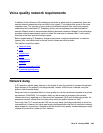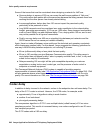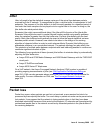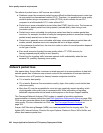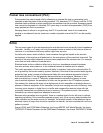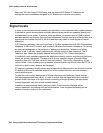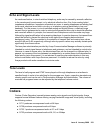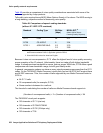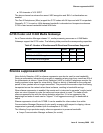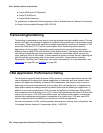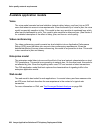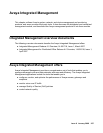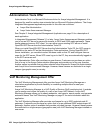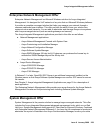
Voice quality network requirements
252 Avaya Application Solutions IP Telephony Deployment Guide
Table 46 provides a comparison of voice quality considerations associated with some of the
codecs supported by Avaya products.
Toll-quality voice must achieve a MOS (Mean Opinion Score) of 4 or above. The MOS scoring is
a long-standing, subjective method of measuring voice quality.
Because it does not use compression, G.711 offers the highest level of voice quality assuming
proper operation of the IP network. Unfortunately, there is a trade-off with higher bandwidth
usage. In situations where bandwidth is scarce, such as across WAN links, G.729 offers a good
compromise with lower bandwidth usage, but still good fidelity audio.
In general, compression codecs use twice as many signal processing resources than the G.711
codec. On the TN2302AP (Media Processor) circuit pack (and on the G700 VoIP engine) there
are 64 DSP resources. Thus, the number of calls supported by one Media Processor board or
G700 is:
● 64 G.711 calls
● 32 compressed calls (for example, G.729)
● Some number in-between for a call mix.
The formula for calculating the number of calls one Media Processor board supports is
The TN2602AP circuit pack supports:
● 320 channels of G.711 (u/a-law)
● 320 channels of G.729A/G.729AB
● 320 channels of G.726 (32 kbps only)
● 320 channels of T.38
Table 46: Comparison of speech coding standards
(without IP / UDP / RTP overhead)
Standard Coding Type Bit Rate
(kbps)
MOS-LQO
1
,
2
(Mean Opinion Score -
Listening Quality Objective)
1. As predicted. Measured according to ITU-IT Recommendation P.862 (PESQ). See
draft Recommendation P.862.2, application guide for PESQ.
2. Given MOS-LQO values for American English.
G.711 PCM 64 4.37
G.729 CS-ACELP 8 3.94
G.723.1 ACELPMP-MLQ 6.3
5.3
3.78
3.68
Number of uncompressed calls()2 Number of compressed calls()× 64≤+




